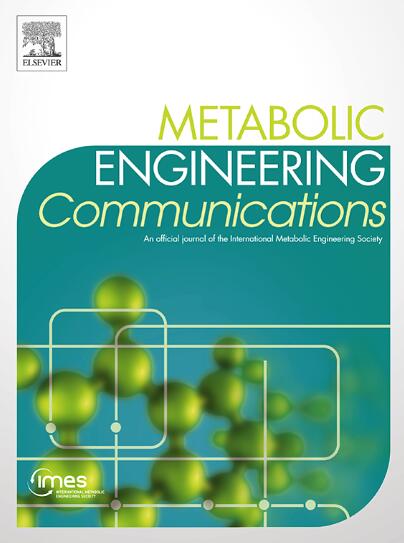Synthetic pathways for microbial biosynthesis of valuable pyrazine derivatives using genetically modified Pseudomonas putida KT2440
IF 4.1
Q2 BIOTECHNOLOGY & APPLIED MICROBIOLOGY
引用次数: 0
Abstract
Using engineered microbes for synthesizing high-valued chemicals from renewable sources is a foundation in synthetic biology, however, it is still in its early stages. Here, we present peculiarities and troubleshooting of the construction of novel synthetic metabolic pathways in genetically modified work-horse Pseudomonas putida KT2440. The combination of this microbial host and heterologous expressed non-heme diiron monooxygenases enabled de novo biosynthesis of 2,5-dimethylpyrazine (2,5-DMP) carboxylic acid and N-oxides as target products. A key intermediate, 2,5-DMP, was obtained by using Pseudomonas putida KT2440Δ6 strain containing six gene deletions in the L-threonine pathway, along with the overexpression of thrAS345F and tdh from E. coli. Thus, the carbon surplus was redirected from glucose through L-threonine metabolism toward the formation of 2,5-DMP, resulting in a product titre of 106 ± 30 mg L−1. By introducing two native genes (thrB and thrC from P. putida KT2440) from the L-threonine biosynthesis pathway, the production of 2,5-DMP was increased to 168 ± 20 mg L−1. The resulting 2,5-DMP was further derivatized through two separate pathways. Recombinant P. putida KT2440 strain harboring xylene monooxygenase (XMO) produced 5-methyl-2-pyrazinecarboxylic acid from glucose as a targeted compound in a product titre of 204 ± 24 mg L−1. The microbial host containing genes of PmlABCDEF monooxygenase (Pml) biosynthesized N-oxides – 2,5-dimethylpyrazine 1-oxide as a main product, and 2,5-dimethylpyrazine 1,4-dioxide as a minor product, reaching product titres of 82 ± 8 mg L−1 and 11 ± 2 mg L−1 respectively.
利用转基因恶臭假单胞菌KT2440合成有价吡嗪衍生物的微生物合成途径
利用工程微生物从可再生资源中合成高价值化学品是合成生物学的基础,然而,它仍处于早期阶段。在这里,我们介绍了在转基因工作马恶臭假单胞菌KT2440中构建新的合成代谢途径的特点和故障排除。该微生物宿主与异种表达的非血红素二铁单加氧酶结合,使2,5-二甲基吡嗪(2,5- dmp)羧酸和n-氧化物作为靶产物重新生物合成。利用含有l -苏氨酸途径中6个基因缺失以及大肠杆菌中thrAS345F和tdh过表达的恶臭假单胞菌KT2440Δ6菌株,获得了关键中间体2,5- dmp。因此,碳过剩通过L-苏氨酸代谢从葡萄糖重定向到2,5- dmp的形成,导致产物滴度为106±30 mg L−1。在L-苏氨酸生物合成途径中引入两个天然基因(来自p.p putida KT2440的thrB和thrC),将2,5- dmp的产量提高到168±20 mg L−1。得到的2,5- dmp通过两个不同的途径进一步衍生化。含有二甲苯单加氧酶(XMO)的重组恶臭p.p . putida KT2440菌株以葡萄糖为目标化合物生产5-甲基-2-吡嗪羧酸,产品滴度为204±24 mg L−1。含有PmlABCDEF单加氧酶(Pml)基因的微生物宿主以n -氧化物- 2,5-二甲基吡嗪1-氧化物为主要产物,以2,5-二甲基吡嗪1,4-二氧化为次要产物,产物滴度分别为82±8 mg L−1和11±2 mg L−1。
本文章由计算机程序翻译,如有差异,请以英文原文为准。
求助全文
约1分钟内获得全文
求助全文
来源期刊

Metabolic Engineering Communications
Medicine-Endocrinology, Diabetes and Metabolism
CiteScore
13.30
自引率
1.90%
发文量
22
审稿时长
18 weeks
期刊介绍:
Metabolic Engineering Communications, a companion title to Metabolic Engineering (MBE), is devoted to publishing original research in the areas of metabolic engineering, synthetic biology, computational biology and systems biology for problems related to metabolism and the engineering of metabolism for the production of fuels, chemicals, and pharmaceuticals. The journal will carry articles on the design, construction, and analysis of biological systems ranging from pathway components to biological complexes and genomes (including genomic, analytical and bioinformatics methods) in suitable host cells to allow them to produce novel compounds of industrial and medical interest. Demonstrations of regulatory designs and synthetic circuits that alter the performance of biochemical pathways and cellular processes will also be presented. Metabolic Engineering Communications complements MBE by publishing articles that are either shorter than those published in the full journal, or which describe key elements of larger metabolic engineering efforts.
 求助内容:
求助内容: 应助结果提醒方式:
应助结果提醒方式:


